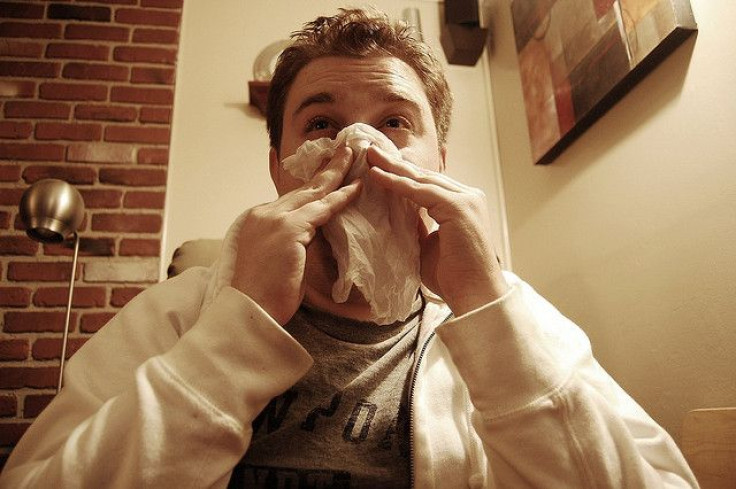Paid Sick Leave Could Reduce Spread Of Flu By Up To 40% In The Workplace

You just woke up, and you're feeling terrible. Fever, sore throat...it's going to be a rough day. Last week your cubicle-mate came to work with the flu and now you're facing the same tough decision: lose a day of wages or risk passing the bug onto someone else.
According to a new study in American Journal of Public Health, bosses could massively reduce the spread of seasonal influenza in workplaces by offering paid sick leave to all of their employees.
Feeling compelled to head to work when you're sick is called 'presenteesism'. Previous studies have shown that 72 percent of people stay home when they have paid sick leave, but only 52 percent do the same without it.
Between 5-20 percent of U.S. residents catch the flu each year, and the Centers for Disease Control and Prevention recommend that people with influenza stay home for at least 24 additional hours after their fever breaks. (Flu medication can mask symptoms, so there is an extra stipulation of starting the countdown after the disue of fever-reducing drugs.)
However, this is a tough choice for many Americans if they have a limited number of paid sick days. "The Bureau of Labor Statistics reports that 33% of the civilian workforce lacked paid sick days in 2010", wrote the authors of this study who were led by Dr. Supriya Kumar, an epidemiologist at the University of Pittsburgh Graduate School of Public Health.
It is also a major political issue. Earlier this week Yahoo News reported, NYC mayor Michael Bloomberg had vetoed a bill that mandates up to 5 days of paid sick leave for an estimated 1 million workers.
"The bill, which will impose significant new costs on employers and create a vast new bureaucracy, is bad for the city's economy, and it will harm the very people it seeks to help," said Bloomberg in a veto message.
The City Council is expected to override his veto.
The policy change would also likely affect some income brackets more than others. In the private and civilian sectors, the 20 percent of employees with the lowest incomes receive paid sick leave, whereas 90 percent of people with the highest compensation can stay home and still get paid when sick.
A 'SimCity' Simulator For The Flu
Kumar and her colleagues investigated whether paid sick leave could impact the spread of flu in workplaces. To do this, they used computers to predict how Allegheny County, Pennsylvania - where Pittsburgh is located - would respond to a 100 day flu outbreak, a standard length for such an event.
Their computer model accounted for every home, school, and business in the county and relied on 'agent-based thinking', which is the same programming now wired into the hit video game franchise "SimCity".
Like the game, each citizen is represented in Kumar's model, along with their social networks, which in this case would be their workplace. The choices of each individual dynamically influence the other members of the simulation.
They found that 'presenteeism' was a huge contributor to the spread of flu. Providing just one day of universal access to sick leave could reduce flu transmission by 25 percent, while two free days dropped the spread of flu by 40 percent.
"Our simulations show that allowing all workers access to paid sick days would reduce illness because fewer workers get the flu over the course of the season if employees are able to stay home and keep the virus from being transmitted to their co-workers," said Kumar.
For their simulation, the authors assumed that small businesses with less than 50 employees would give 30 percent fewer paid sick days relative to businesses with over 500 employees. Mid-sized businesses fell between this range. Their assumptions were based on data from the National Compensation Survey.
"Many more workers in small workplaces than in large ones lack access to paid sick days and hence find it difficult to stay home when ill," said Kumar. "These findings make a strong case for paid sick days. Future research should examine the economic impacts of paid sick-day policies."
The modeling system, called "Framework for Reconstructing Epidemic Dynamics" (FRED), was developed at Pitt Public Health and offers a dynamic tool for studying pandemics and possible public health interventions.
"Our mission is to protect the U.S. and the global community against communicable infectious disease threats," said senior author Dr. Donald Burke, Pitt Public Health dean and UPMC-Jonas Salk Chair of Global Health. "Our modeling work allows scientists both here and worldwide to investigate strategies to minimize epidemics. At the heart of this effort is free, open data sharing."
Source: Kumar S, Grefenstette JJ, Galloway D, Albert SM, Burke DS. Policies to Reduce Influenza in the Workplace: Impact Assessments Using an Agent-Based Model. American Journal of Public Health. 2013.



























